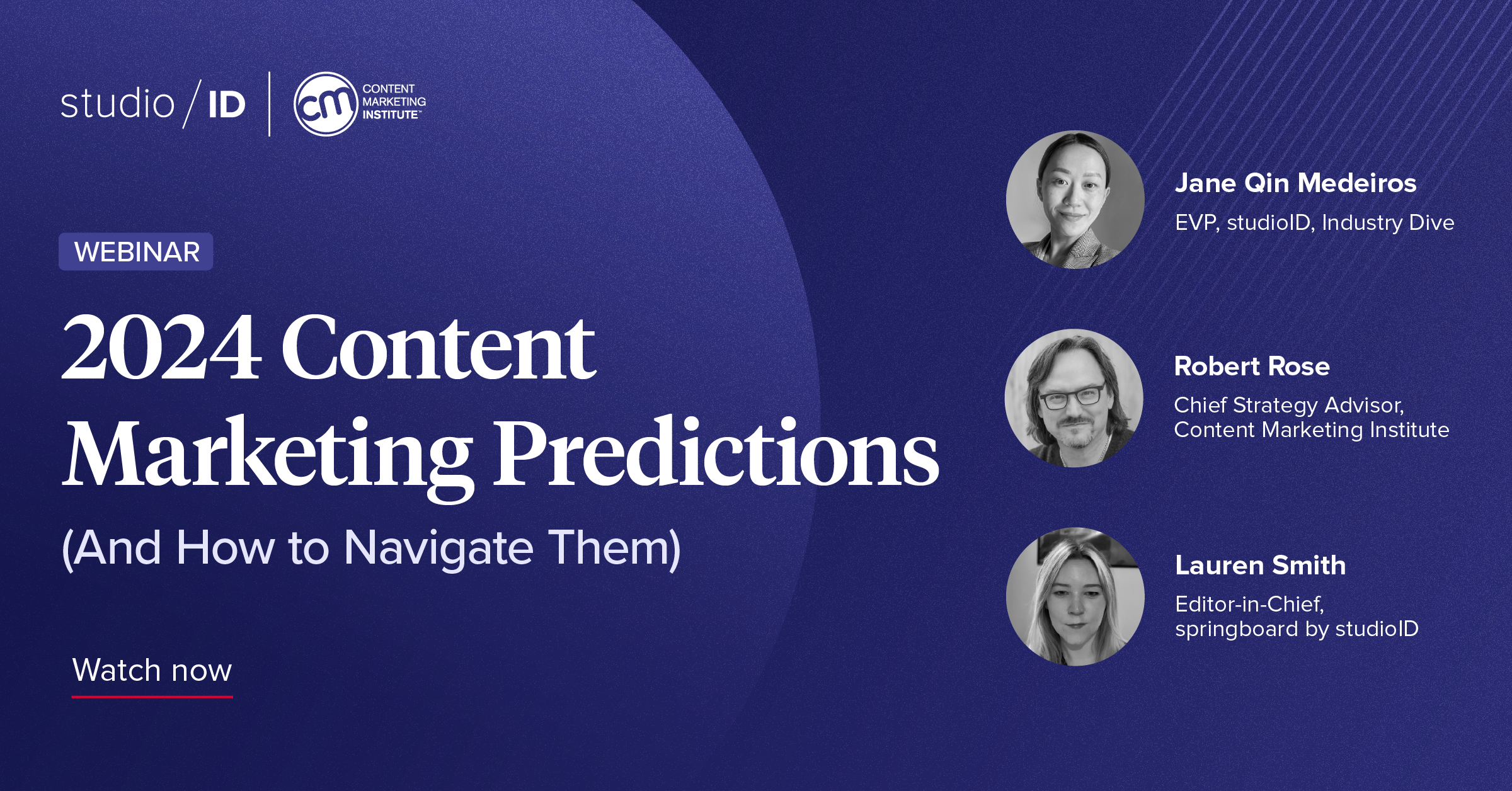Table of Contents
- 2024 Content Marketing Predictions
- Prediction: The Best Will Use Generative AI to Boost — Not Replace — Creativity
- Prediction: Social Media Will Continue its Reign in 2024
- Prediction: Yes, We’re Going to Talk More About Money
- 2024 Demand Generation Predictions
- Prediction: Personalization Will Become Paramount
- Prediction: Sights Will Get Set on Lower-Funnel Activities in 2024
- Prediction: Internal Misalignment Will Consume Budgets and Lose Deals
How would you describe your marketing team’s 2023?
A better year than most? You grinded it out? Or, so rough you’re not ready to talk about it?
Annual prediction stories should be both aspirational and brimming with actionable strategies. And this one is no exception. But we’d be remiss if we didn’t start by acknowledging the extreme pressures weighing on marketers at the start of 2024.
The 400 marketing leaders who responded to studioID’s 2024 Content Marketing and Demand Generation Predictions survey still have 2023’s money concerns on their minds:
-
Twenty-five percent of demand generation marketers and 18% of content marketers expect their budgets to decrease year over year.
-
Both groups listed budget cuts among the top four potential roadblocks to achieving their 2024 goals.
But while budget is a top concern, its presence – or lack thereof – doesn’t have the power to reshape the practices of an entire industry. So, as we explore survey results and expert insights into how marketers can best approach the content and demand generation opportunities of 2024, let’s start with the one area that does: the adoption and deployment of generative artificial intelligence.
🔮 Related Resource: 2024 Content Marketing Predictions [Infographic]
2024 Content Marketing Predictions
Prediction: The Best Will Use Generative AI to Boost — Not Replace — Creativity
Generative AI is the hottest marketing term since omnichannel (and you know how much marketers love to toss out an “omnichannel” in conversation). But in 2024 and onward, the best content marketers won’t use AI in place of human creativity — but rather, to boost it. And the content marketers who do use the tech to cut out the creative human element will find themselves in a rapid race to the bottom.
Everyone and their dog think they can use LLMs (large language models) to create content to drive their sales funnel and build their reputation. 2024 will be the year where we see what happens when they try. … Maybe by the end of 2024, human creators will be even more valuable than ever as a backlash against bad content begins.
— Ellen Lichtenstein, Senior Content Specialist at AgentSync, via CMI
While there’s not as much bullishness around content marketing budget growth this year as past years, 38% of content marketer respondents said they expect to increase spend on AI tools, platforms, and training if funds allow. The allure of generative AI to this group is clear: more ideas, and faster.
When asked to select the top ways they plan to leverage AI in 2024, 61% of content marketers selected ‘brainstorming content concepts,’ with no other answer finishing above 35%.
The race for ideas matches up well with content marketers’ No. 1 priority. Fifty-six percent of respondents indicated their top focus this year will be telling more engaging stories – the second year in a row storytelling has grabbed the top spot in that category. The big question, however, will be how this focus on storytelling plays out, as 12% of respondents said they feel pressured to use generative AI to increase efficiency in creative endeavors this year.
We’ve already seen a few cautionary tales surrounding this content marketing trend, including AI-powered “SEO heists” and the use of fake writers leading to the removal of some C-suite leaders. While these tactics may seem appealing to brands looking for a shortcut, they should sound the alarm on ethics and content sameness for savvy content marketers. The recent Informa Tech Trust in Marketing Index underlines that concern, as it found the top trust-reducing action B2B content marketers can make is introducing dated or oft-repeated content.
How Content Marketers Should Approach Generative AI in 2024
For now, winning the generative AI game requires a simple plan: treat your creative team as the star, and let generative AI be the best supporting actor.
Having generative AI as an always-ready ideation co-pilot and junior data analyst is a huge advantage. But it’s not a replacement for content marketers’ knowledge of what their niche audiences need.
In an already saturated landscape that’s now being flooded with AI-generated content, it will be the narratives, copy, and designs developed by real people that strike us and stick with us. After all, how could we expect something innately artificial to be better at reflecting the nuances of the human experience than humans themselves?
— Lauren Smith, Editor-in-Chief, springboard by studioID
Creators should centralize their AI focus on time-saving measures – 29% of content marketers cited automation of tasks as one of the top three ways they planned to use AI – as opposed to having AI produce chunks of unoriginal text that won’t be nearly as compelling to your audience (and in fact, could wind up diminishing your credibility).
The good news is generative AI can seriously up your game when it comes to the desire to tell better stories (it just won’t create those compelling stories for you). Marketers should take the insights that have powered their historically successful content, add in their 2024 organizational needs, and then use generative AI to help brainstorm new angles for tentpole content that will support new campaigns. Ideally, these tentpoles will reveal new perspectives and information – including the creation of surveys like the one you’re reading – that will be of significant value to your audience.
It’s also worth exploring the other top use cases for AI indicated by our respondents, which include producing drafts of promotional copy/derivative assets for larger content pieces (35%), aiding in audience & topic research (32%), and SEO planning and optimization (29%).
[AI] is going to change the way that we work. So for people who [want to] grow in their role, a new way to do that is now to learn how to work as best as you can with these systems to speed up the processes that need to be sped up, in the same way that someone using a screwdriver is not going to be as fast as someone using a drill.
— Liam Berry, Senior Content Strategist, Marketing Strategy at studioID via an AI webinar by Informa Tech
Prediction: Social Media Will Continue its Reign in 2024
If you didn’t post it, did it even really happen? If you’re not on TikTok, do you even matter? While the answers to these questions are certainly yes and yes, some marketers may have reflexively paused before they replied.
Our 2024 Content Marketing Predictions survey showed how much sway social channels still hold. When content marketers were asked to forecast their most-successful tactics, social reigned supreme:
-
Top two channels to reach prospects:
-
Organic social media (54%) and paid social media (48%)
-
-
Top format to reach audiences:
-
Social media posts (71%) – including the likes of short-form videos and static posts
-
In fact, social posts were the only format cited by more than 50% of respondents.
But content marketers understand the risk of building on rented land, too. Fifty percent of content marketing respondents said platform changes (including updates to algorithms, like those that dictate social media reach) are the top external roadblock they’re worried about navigating in 2024 – the most selected roadblock on the list.
How Content Marketers Should Approach Social Media in 2024
There’s no marketing mirage quite like a bloated social media follower count. But will big numbers matter if your brand can’t translate them into big dollars? In 2024, content marketers need to think quality over quantity. Gaudy stats are great, but they won’t matter if your key prospects and top industry influencers aren’t engaging.
Bringing as many current and potential buyers and influencers into your social orbit as possible can make more of a difference than anything you can create. Stats from Informa Tech back it up, as they found:
75% of B2B buyers use social media to help make buying decisions.
And according to the 2022 Edelman Trust Barometer, 63% of people ages 18 to 34 (the B2B buyers of tomorrow) trust influencer opinions of a brand more than what a brand has to say about itself.
While a viral social media post can feel like a huge win, content marketers need to be critical about how much ROI their organization is driving from social alone. It’s easy to imagine demand generation marketers reading this section and thinking “why are they spending so much time on social channels when those don’t convert as well as other investments?”
The bottom line becomes clear: your distribution strategy must be customized to your brand and your goals. Find out where your ideal customer is concentrated and unravel the tactics that are actually converting prospects to customers, and test and invest there. It’s a mistake to go all-in on social just for the sake of keeping up with competitors.
Remember why your audience followed you on social in the first place: they saw something in your brand that connected to their interests and identity, and brought them into the same space with like-minded people. To succeed on social in 2024, you are going to have to invest in building this connection and putting the ‘networking’ back in social network.
— Travis Gonzalez, Strategy Director, studioID
Prediction: Yes, We’re Going to Talk More About Money
Financial markets may have spiked in Q4, but content marketing budgets were still being viewed skeptically as we entered 2024.
Sixty-one percent of content marketers expect their budgets to stay static or decrease year over year. And the 18% predicting budget decreases is more than three times higher than the number who predicted rollbacks in last year’s survey.
Content marketers were particularly split on brand awareness budgets, choosing them both as the most likely area to increase in 2024 and the second most likely area to decrease. Perhaps unsurprisingly, this divisiveness is reflected in the content goals that were – and weren’t – selected, as respondent organizations’ top focus for 2024:
- Generating more qualified leads (35%) and growing audience (32%) were the top two selected priorities for content marketers in 2024.
- Improving brand reputation (13%) and creating brand loyalists (5%) – both results of brand awareness plays – were the least selected priorities.
Finally, when asked to select the roadblocks most likely to hinder the creativity of their content marketing in 2024, 30% of respondents said there was no room in the budget for creative spend, edging out lack of strategic guidance from leadership (27%) as the top projected hurdle. The third and fourth most selected answers were budget-related as well: potential recession challenges (20%) and budget cuts (18%).
How to Maximize Content Marketing Budgets in 2024
Content marketers have never had more opportunities to optimize to preserve budgets. As your team gets more comfortable automating tasks with AI, start thinking about small content changes – both creative and operational – you can make that will boost your ROI.
We’ll get you started: studioID’s 13 Winning Campaigns to Maximize Your Lead Generation analyzed nearly 1,000 campaigns over the course of a year to pinpoint what content approaches generated the highest engagement by theme and headline execution.
Want to demonstrate more ROI to preserve your creative budget? Don’t neglect the down-funnel or end-of-journey content. While content like partner case studies can be incredibly hard to get approved, spending time producing the ones you can green light may prove invaluable in closing future deals. Providing case studies was also the No. 1 trust-building action cited by B2B technology buyers in the Informa Tech 2023 Trust in Marketing Index.
A thoughtful and informed content strategy makes the most of every dollar. Determine what conversations you want to own this year and lock in your content plan, so you don’t spend precious time (and budget!) re-ideating every short-form blog or social post. If you prioritize proprietary insights for big rock pieces — custom survey data, case studies — your derivative pieces will avoid the trap of stale and repetitive content.
— Kate Light, Senior Content Director, Content at, studioID
Start thinking now about how you’ll justify preserving your 2024 creative spend before it gets in your CFO’s crosshairs. Decreasing spend on freelancers/outsourcing has been the most selected cost-cutting tactic in our survey the last two years (cited by 23% of respondents last year and 17% this year). But that’s hard to reconcile against content marketers’ stated needs for differentiated storytelling. If you have to choose, make sure to preserve enough to pay for original tentpole pieces. You can worry about how to create derivative pieces later, once the hardest insights-generating work is already completed by an expert in the field.
Illusion: Contemporary technology has found an easy way to achieve your goals on the cheap. Reality: Everyone has access to the same ‘cheap-and-easy’ tools you have. Unless you’re prepared to apply critical thinking and lots of elbow grease to your challenges, you’re going to get the same mediocre, lackluster results as your competition.
— Jonathan Kranz, Principal at Kranz Communication, via CMI
Want to dig deeper? Watch studioID’s on demand webinar for more expert analysis on the top 3 trends to dominate content marketing in 2024.
2024 Demand Generation Predictions
Prediction: Personalization Will Become Paramount
Clicks are cool. Likes are lovely. But if you don’t know your executive buyers’ middle names, are you even a serious demand generation marketer today? While we may not need to get that personal, survey respondents did see personalization in the form of knowledge and nurturing relationships as the most important demand generation marketing trends.
Sixty percent of demand generation marketing respondents said optimizing audience targeting to reach the right leads was their top priority for their organizations, with creating more personalized campaigns coming in second at 34%.
And demand generation marketers selected account-based marketing (42%) as the No. 2 channel they predict to be most successful in generating demand in 2024 (with the vehicle of content marketing and thought leadership coming in first at 50%).
Also, 40% of demand generation marketers predict their remarketing campaign budgets will increase if budget adjustments are made throughout 2024 — the second most popular answer behind budget boosts for AI and automation technology (46%).
B2B campaigns are increasingly adopting the creativity seen in B2C campaigns. That’s because audiences crave a personal connection. Successful marketers are leveraging emotional appeals with a focus on being distinct and memorable, marking an ongoing shift towards a more human-centric approach in content marketing irrespective of the business context.
— Lieu Pham, VP of Strategy at studioID
How Demand Generation Marketers Can Boost Personalization in 2024
If you want to get personal, you must dive into the data. Sharpening your ideal customer profile (ICP) – which is a composite of the most significant demographic, firmographic, and behavioral traits of your ideal buyers – is the first step. That’s because personalization – usually in the form of a highly-coordinated account-based marketing effort – is both expensive and pointless if you don’t have the right targets in your sights.
Also, demand generation marketers will look to AI for help, as 41% of respondents said they’ll leverage AI to enhance targeting and personalization – the third-most popular use of the technology selected. But training AI to spot patterns, and even interact with customers, will be key. Notably, chatbots are growing in utility and becoming more accepted by consumers.
A 2023 Tidio study found 62% of consumers would rather talk to a chatbot if the alternative was waiting 15 minutes to speak to a human customer service representative.
It sounds like a lot, but all this work can pay off: Twilio Segment’s State of Personalization Report 2023 found 56% of consumers said they’d become repeat buyers after a personalized experience, up 7% from the previous year.
Personalization and hyper-segmentation are becoming increasingly important. … The scalable automation of hyper-personalized content will emerge [in 2024], driving more demand for this type of creation and consumption model.
— Yadin Porter de León, Global Executive Content Marketing Lead at VMware, as told to CMI
Prediction: Sights Will Get Set on Lower-Funnel Activities in 2024
Great performing content guarantees more customers, right? If only that were true. While top-of-funnel content is usually the most widely read content, engaging your widest possible audience with actionable insights doesn’t usually result in quick sales. That’s why we predict demand generation marketers will aim lower in the funnel for 2024.
While personalization finished atop the priorities list in our survey, the most selected focus points for demand generation marketers – improvements that will support those top priorities – were enhancing quality of leads generated (39%) and increasing conversion rate from lead to MQL (26%). Those aligned roughly with what demand generation marketers saw as their two biggest challenges: competing priorities and limited bandwidth (21%) and MQLs failing to convert to customers (19%).
Where do all these dots connect? Lower-funnel and late-journey content, which can create engagements and resulting data that better signal intent.
How Demand Generation Marketers Can Target More Conversions in 2024
Once you’ve addressed your ICP, demand generation marketers should link up with their content-creating colleagues to lock in a lower-funnel content production roadmap for 2024. From there, monitor which new MQLs and pre-existing ABM accounts interact with this content (and how they interact with it).
There’s two down-funnel content formats in particular that typically (1) indicate high intent and (2) tend to be easier to pull off if you have experts on your team:
-
Case studies: These seals of approval from clients are equally coveted and hard to execute because of perception and legal concerns between brands. But case studies repeatedly prove that story-based messaging drives engagement and increases conversions (up to 400% in some instances).
-
Webinars: According to the 2022 Informa Engage survey, webinar registrations are 43.5% more likely to be correlated with a purchase than other content format sign-ups. Live webinar attendees may be even more lucrative, as they’re showing enough interest in your insights and solutions to engage with you on your timetable.
-
Marketers are ready to action on webinars, too. The format was the second most selected answer (44%) behind video (49%) when demand generation marketers were asked which campaign types were most likely to generate demand in 2024.
-
[Content is] at its most powerful, not as an end in itself — to drive traffic or leads — but rather as a means (a substantive excuse) to build relationships. Content must be accompanied by a distribution strategy at the individual level. This elevates the need for quality production as well as the need for reimagining the role of content in demand generation.
— Aaron Orendorff, Head of Marketing at Recart, as told to CMI
Prediction: Internal Misalignment Will Consume Budgets and Lose Deals
Marketing can be a tough business. And teams that aren’t on the same page are making it that much harder to achieve their cumulative goals.
Our survey reveals industry-wide misalignment does exist. Both demand generation marketers (21%) and content marketers (29%) predict competing priorities and limited bandwidth will be their biggest challenge in 2024. And to complicate matters further, the priorities content marketers and demand generation marketers gave didn’t always align.
Case in point: Paid social media and organic social media – seen as the top two channels for successfully reaching prospects by the content marketing respondents – aren’t seen as having the same level of impact by their demand gen counterparts. Demand generation marketers put paid social media third on their list (30%) and ranked organic social media eighth (17%) when it comes to expected success in generating demand in 2024.
You need to fine-tune your personas and create content that resonates with your total relevant market — relevant being the keyword here. Don’t fall into the trap of sending a lead who is not ready or prime over to sales. You will lose trust in that very important sales/marketing relationship, and your conversions will drop. Dedicate yourself to quality over quantity, and the results will speak for themselves.
— Connor Flanagan, Director of Revenue Marketing at studioID
How to Align Your Content Marketing and Demand Generation Teams in 2024
There’s a way to combat this where everyone wins and you don’t waste budget in the process: meticulously planned, full-journey, atomized content campaigns.
While every idea won’t be both a winning social media campaign and a lead-generating webinar, your most compelling ideas will have some full-journey atomization opportunities. When your content marketing team sets its tentpole pieces for 2024 – more on that in the above content marketing trends section – make sure your demand generation team is there advocating for the highest ROI formats that can cover the full buyer journey.
Marketing and sales alignment creates tangible benefits, including better retention, higher win rates, and increased revenue. Knowing what the business goals and processes are at each stage of the customer journey will power your ability to make your content drive even greater business outcomes.
— DeAnna Ransom, CEO at Red Monkey Consulting, as told to CMI
🔮 Related Resource: 2024 Demand Generation Predictions [Infographic]
![]()









